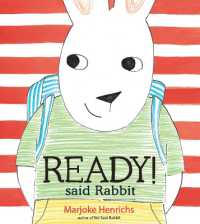Full Description
As social studies standards shift to place a higher emphasis on critical thinking, inquiry, interaction, and expression, many teachers are scrambling to figure out how to appropriately shift their instruction accordingly. This book provides examples and ideas for working with elementary and middle school students to build social studies skills and knowledge in order to become independent learners and thinkers. Teaching these skills helps to support students in ways which are important to them, and to society at large.
Real Classrooms, Real Teachers: The C3 Inquiry in Practice is aimed at in-service and pre-service teachers, grades 3-8. This text includes six sections: an introduction, one section for each of the four dimensions of the C3 Framework for Social Studies State Standards (National Council for the Social Studies, 2013), and a conclusion. Each chapter begins with a vignette based on a real-life social studies lesson authored by a practicing teacher or researcher. This is followed by a sample lesson plan associated with the vignette and suggestions for appropriate texts and supporting materials, as well as suggestions for modifications.
Contents
Section I. Introduction.
Chapter 1. Introduction; Kristy A. Brugar and Kathryn L. Roberts.
Chapter 2. How to Use this Book; Kathryn L. Roberts and Kristy A. Brugar.
Section II. Dimension 1: Questioning.
Chapter 3. Dimension One: Developing Questions and Planning Inquiries; Stephanie L. Strachan.
Chapter 4. Developing Questions: Civics Inquiry into a Public Issue; Linda Doornbos.
Chapter 5. Centering History Instruction Around Primary Sources; Kristy A. Brugar.
Section III. Dimension 2: Concepts And Tools.
Chapter 6. Dimension 2: Applying Disciplinary Concepts and Tools; Kristy A. Brugar and Kathryn L. Roberts.
Chapter 7. Concepts and Tools, Civics: Gentrification in Jersey City; Mary McGriff and Omar Alvarez.
Chapter 8. Concepts and Tools, Economics: Learning about Concepts of Entrepreneurship from the Goo Crew; Annie McMahon Whitlock.
Chapter 9. Concepts and Tools, Geography: Mapping the Constitutional Convention; Kathryn L. Roberts and Kristy A. Brugar.
Chapter 10. Concepts and Tools, History: Bells, Boats, and Budding Historians; Alisa Kesler-Lund.
Section IV. Dimension 3: Evaluating Sources.
Chapter 11. Dimension 3: Evaluating Sources and Using Evidence; Sean McBrady and Min Yu.
Chapter 12. Evaluating Sources; Troy Hicks.
Chapter 13. Evaluating Sources; Tom Bober.
Section V. Dimension 4: Communicating Conclusions And Taking Informed Action.
Chapter 14. Dimension 4: Communicating Conclusions and Taking Informed Action; Amy Allen.
Chapter 15. Communicating Findings: Crafting a Stance on Critical Social Issues; Cassie Brownell and Nicole Haney.
Chapter 16. Supporting Lived Civics: Taking Informed Action in a Fourth-Grade Classroom; Stephanie Serriere, Angie Kirkham, and Ana Carolina Diaz Beltran.
Section VI. Conclusion.
Chapter 17. Conclusion; Kamrin Ratcliff, Kathryn L. Roberts, and Kristy A. Brugar.







